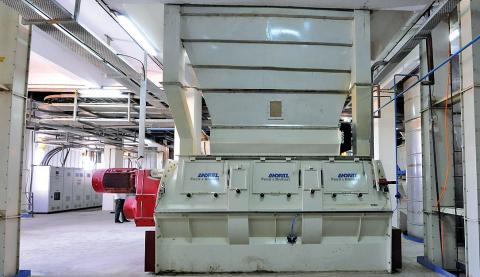3.1.5 Mixing operation-Dry
The mixing process determines, to a high degree, the capacity of the whole manufacturing process and the quality of the final product. Lack of proper mixing can lead to reduced diet uniformity, affecting not only animal performance but regulatory compliance as well. Mixing of batch in batch mixer (Fig. 3.6) is done generally for 3 to 4 minutes for proper mixing. The mixing accuracy/ homogeneity of a mixer indicates how efficiently a single ingredient is distributed among the totality of other ingredients. The homogeneity (Fig. 3.7) is expressed by the coefficient of variation CV (per cent). A good mixer should have a CV ≤ 5 per cent in less mixing time. Interlocks are provided to ensure that only one batch at a time is mixed in the mixer. Quality control officer should also check for proper mixing of batch ingredients in mixed feed.
Fig. 3.6 Batch mixer
The influencing factors on the mixing accuracy are:
• Properties of components: Best mixing results are achieved, if the particles in a mixture have only small differences in regard to granulation and specific weight
Rule of thumb:
• Granulation: Differences between components max. 3 mm
• Bulk density: Differences between the components smaller 0.5 t/m3
• Accuracy of proportioning: Proportioning has to fulfil the requirements
• Type of mixer (conical, U-shaped)
• Mixing time: Specific for each mixer type. The mixing time of conical shaped mixer: 5-20 min, circular horizontal single ribbon / peddle type mixer – 3 to 4 minutes and horizontal twin shaft paddles -1 to 2 minutes.
• Liquid addition: Liquids have to be added after the mixing process.
While going around the plant, the animal nutrition officer should ensure that the operators are cautious about the effects of using less or more raw materials. He should ensure that weighing of raw material is in accordance with the feed formula. Periodically, he should also check accuracy of the scale.

